No edit summary Tag: Source edit |
No edit summary Tag: Source edit |
||
| Line 213: | Line 213: | ||
[[Category:Yu-Gi-Oh Creatures]] |
[[Category:Yu-Gi-Oh Creatures]] |
||
[[Category:Dinotopia Creatures]] |
[[Category:Dinotopia Creatures]] |
||
| − | [[Category:Mongolian |
+ | [[Category:Mongolian dinosaur]] |
Revision as of 08:16, 23 January 2021
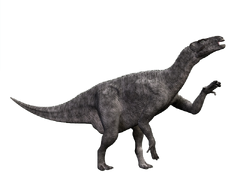
| |
| A restoration of Iguanodon bernissartensis | |
| Scientific classification | |
| Kingdom: | Animalia |
| Phylum: | Chordata |
| Class: | Sauropsida |
| clade: | Dinosauria |
| Superorder: | Ornithopodomorpha |
| Family: | †Iguanodontidae |
| Genus: | †Iguanodon Mantell, 1825 |
| Type species | |
| †Iguanodon bernissartensis Boulenger, 1881 | |
| Referred species | |
| |
| Synonyms | |
| |
Iguanodon (i·guan·o·don) is a genus of ornithopod dinosaur that lived from about 139-138 million years ago, from the early to late Cretaceous period. Iguanodon was the second dinosaur ever discovered and it was one of the first dinosaurs to be named, preceded only by Megalosaurus. Iguanodon's name means "iguana tooth" due to its iguana-like teeth. It was the largest of its kind.
It lived in Antartica, North Africa, Mongolia and Europe, mainly in England in the UK and Belgium.
Discovery and history
The discovery of Iguanodon has long been accompanied by a popular legend. The story goes that Gideon Mantell's wife, Mary Ann, discovered the first teeth of an Iguanodon in the strata of Tilgate Forest in Whitemans Green, Cuckfield, Sussex, England, in 1822 while her husband was visiting a patient. However, there is no evidence that Mantell took his wife with him while seeing patients. Furthermore, he admitted in 1851 that he himself had found the teeth, although he had previously stated in 1827 that Mrs. Mantell had indeed found the first of the teeth later named Iguanodon. Other later authors agree that the story is not certainly false. It is known from his notebooks that Mantell first acquired large fossil bones from the quarry at Whitemans Green in 1820. Because also theropod teeth were found, thus belonging to carnivores, he at first interpreted these bones, which he tried to combine into a partial skeleton, as those of a giant crocodile. In 1821 Mantell mentioned the find of herbivorous teeth and began to consider the possibility that a large herbivorous reptile was present in the strata. However, in his 1822 publication Fossils of the South Downs he as yet did not dare to suggest a connection between the teeth and his very incomplete skeleton, presuming that his finds presented two large forms, one carnivorous ("an animal of the Lizard Tribe of enormous magnitude"), the other herbivorous.
In May 1822 he first presented the herbivorous teeth to the Royal Society of London but the members, among them William Buckland, dismissed them as fish teeth or the incisors of a rhinoceros from a Tertiary stratum. On 23 June 1823 Charles Lyell showed some to Georges Cuvier, during a soiree in Paris, but the famous French naturalist at once dismissed them as those of a rhinoceros. Though the very next day Cuvier retracted, Lyell reported only the dismissal to Mantell, who became rather diffident about the issue. In 1824 Buckland described Megalosaurus and was on that occasion invited to visit Mantell's collection. Seeing the bones on 6 March he agreed that these were of some giant saurian—though still denying it was a herbivore. Emboldened nevertheless, Mantell again sent some teeth to Cuvier, who answered on 22 June 1824 that he had determined that they were reptilian and quite possibly belonged to a giant herbivore. In a new edition that year of his Recherches sur les Ossemens Fossiles Cuvier admitted his earlier mistake, leading to an immediate acceptance of Mantell, and his new saurian, in scientific circles. Mantell tried to corroborate his theory further by finding a modern-day parallel among extant reptiles. In September 1824 he visited the Royal College of Surgeons but at first failed to find comparable teeth. However, assistant-curator Samuel Stutchbury recognised that they resembled those of an iguana he had recently prepared, albeit twenty times longer. Mantell's "Iguanodon" restoration based on the Maidstone Mantellodon remains
In recognition of the resemblance of the teeth to those of the iguana, Mantell decided to name his new animal Iguanodon or "iguana-tooth", from iguana and the Greek word ὀδών (odon, odontos or "tooth"). Based on isometric scaling, he estimated that the creature might have been up to 18 metres (59 feet) long, more than the 12-metre (39 ft) length of Megalosaurus. His initial idea for a name was Iguana-saurus ("Iguana lizard"), but his friend William Daniel Conybeare suggested that that name was more applicable to the iguana itself, so a better name would be Iguanoides ("Iguana-like") or Iguanodon. He neglected to add a specific name to form a proper binomial, but one was supplied in 1829 by Friedrich Holl: I. anglicum, which was later amended to I. anglicus. Fossil iguanodont remains found in Maidstone in 1834, now classified as Mantellisaurus Mantell sent a letter detailing his discovery to the local Portsmouth Philosophical Society in December 1824, several weeks after settling on a name for the fossil creature. The letter was read to members of the Society at a meeting on 17 December, and a report was published in the Hampshire Telegraph the following Monday, 20 December, which announced the name, mis-spelt as "Iguanadon". Mantell formally published his findings on 10 February 1825, when he presented a paper on the remains to the Royal Society of London.
A more complete specimen of similar animal was discovered in a quarry in Maidstone, Kent, in 1834 (lower Lower Greensand Formation), which Mantell soon acquired. He was led to identify it as an Iguanodon based on its distinctive teeth. The Maidstone slab was utilized in the first skeletal reconstructions and artistic renderings of Iguanodon, but due to its incompleteness, Mantell made some mistakes, the most famous of which was the placement of what he thought was a horn on the nose. The discovery of much better specimens in later years revealed that the horn was actually a modified thumb. Still encased in rock, the Maidstone skeleton is currently displayed at the Natural History Museum in London. The borough of Maidstone commemorated this find by adding an Iguanodon as a supporter to their coat of arms in 1949. This specimen has become linked with the name I. mantelli, a species named in 1832 by Christian Erich Hermann von Meyer in place of I. anglicus, but it actually comes from a different formation than the original I. mantelli/I. anglicus material. The Maidstone specimen, also known as Gideon Mantell's "Mantel-piece", and formally labelled NHMUK 3741 was subsequently excluded from Iguanodon. It is classified as cf. Mantellisaurus by McDonald (2012); as cf. Mantellisaurus atherfieldensis by Norman (2012); and made the holotype of a separate species Mantellodon carpenteri by Paul (2012), but this is considered dubious and it is generally considered a specimen of Mantellisaurus Statues in Crystal Palace Park based on the Maidstone specimen of "Iguanodon", designed by Benjamin Waterhouse Hawkins, after restoration in 2002
At the same time, tension began to build between Mantell and Richard Owen, an ambitious scientist with much better funding and society connections in the turbulent worlds of Reform Act-era British politics and science. Owen, a firm creationist, opposed the early versions of evolutionary science ("transmutationism") then being debated and used what he would soon coin as dinosaurs as a weapon in this conflict. With the paper describing Dinosauria, he scaled down dinosaurs from lengths of over 61 metres (200 feet), determined that they were not simply giant lizards, and put forward that they were advanced and mammal-like, characteristics given to them by God; according to the understanding of the time, they could not have been "transmuted" from reptiles to mammal-like creatures.
In 1849, a few years before his death in 1852, Mantell realised that iguanodonts were not heavy, pachyderm-like animals, as Owen was putting forward, but had slender forelimbs; however, his passing left him unable to participate in the creation of the Crystal Palace dinosaur sculptures, and so Owen's vision of the dinosaurs became that seen by the public for decades. With Benjamin Waterhouse Hawkins, he had nearly two dozen lifesize sculptures of various prehistoric animals built out of concrete sculpted over a steel and brick framework; two iguanodonts (based on the Maidstone specimen), one standing and one resting on its belly, were included. Before the sculpture of the standing iguanodont was completed, he held a banquet for twenty inside it.
Description
Iguanodon were bulky herbivores that could shift from bipedality to quadrupedality. The only well-supported species, I. bernissartensis, is estimated to have weighed about 3.08 tonnes (3.4 tons) on average, and measured about 10 metres (33 feet) long as an adult, with some specimens possibly as long as 13 metres (43 feet). These animals had large, tall but narrow skulls, with toothless beaks probably covered with keratin, and teeth like those of iguanas, but much larger and more closely packed.
The arms of I. bernissartensis were long (up to 75% the length of the legs) and robust, with rather inflexible hands built so that the three central fingers could bear weight. The thumbs were conical spikes that stuck out away from the three main digits. In early restorations, the spike was placed on the animal's nose. Later fossils revealed the true nature of the thumb spikes, although their exact function is still debated. They could have been used for defense, or for foraging for food. The little finger was elongated and dextrous, and could have been used to manipulate objects. The phalangeal formula is 2-3-3-2-4, meaning that the innermost finger (phalange) has two bones, the next has three, etc. The legs were powerful, but not built for running, and each foot had three toes. The backbone and tail were supported and stiffened by ossified tendons, which were tendons that turned to bone during life (these rod-like bones are usually omitted from skeletal mounts and drawings). Restoration showing I. bernissartensis in quadrupedal pose
Iguanodon teeth are, as the name suggests, like those of an iguana, but larger. Unlike hadrosaurids, which had columns of replacement teeth, Iguanodon only had one replacement tooth at a time for each position. The upper jaw held up to 29 teeth per side, with none at the front of the jaw, and the lower jaw 25; the numbers differ because teeth in the lower jaw are broader than those in the upper. Because the tooth rows are deeply inset from the outside of the jaws, and because of other anatomical details, it is believed that, as with most other ornithischians, Iguanodon had some sort of cheek-like structure, muscular or non-muscular, to retain food in the mouth.
Classification and evolution
iguanodon gives its name to the unranked clade Iguanodontia, a very populous group of ornithopods with many species known from the Middle Jurassic to the Late Cretaceous. Aside from Iguanodon, the best-known members of the clade include Dryosaurus, Camptosaurus, Ouranosaurus, and the duck-bills, or hadrosaurs. In older sources, Iguanodontidae was shown as a distinct family. This family traditionally has been something of a wastebasket taxon, including ornithopods that were neither hypsilophodontids or hadrosaurids. In practice, animals like Callovosaurus, Camptosaurus, Craspedodon, Kangnasaurus, Mochlodon, Muttaburrasaurus, Ouranosaurus, and Probactrosaurus were usually assigned to this family.
With the advent of cladistic analyses, Iguanodontidae was traditionally construed was shown to be paraphyletic, and these animals are recognised to fall at different points in relation to hadrosaurs on a cladogram, instead of in a single distinct clade. Essentially, the modern concept of Iguanodontidae currently includes only Iguanodon. Groups like Iguanodontoidea are still used as unranked clades in the scientific literature, though many traditional iguanodontids are now included in the superfamily Hadrosauroidea. Iguanodon lies between Camptosaurus and Ouranosaurus in cladograms, and is probably descended from a camptosaur-like animal. At one point, Jack Horner suggested, based mostly on skull features, that hadrosaurids actually formed two more distantly related groups, with Iguanodon on the line to the flat-headed hadrosaurines, and Ouranosaurus on the line to the crested lambeosaurines, but his proposal has been rejected.
Species
Because Iguanodon is one of the first dinosaur genera to have been named, numerous species have been assigned to it. While never becoming the wastebasket taxon several other early genera of dinosaurs (such as Megalosaurus) became, Iguanodon has had a complicated history, and its taxonomy continues to undergo revisions. Although Gregory Paul recommended restricting I. bernissartensis to the famous sample from Bernissart, ornithopod workers like Norman and McDonald have disagreed with Paul's recommendations, except exercising caution when accepting records of Iguanodon from France and Spain as valid.
I. anglicus was the original type species, but the lectotype was based on a single tooth and only partial remains of the species have been recovered since. In March 2000, the International Commission on Zoological Nomenclature changed the type species to the much better known I. bernissartensis, with the new holotype being IRSNB 1534. The original Iguanodon tooth is held at Te Papa Tongarewa, the national museum of New Zealand in Wellington, although it is not on display. The fossil arrived in New Zealand following the move of Gideon Mantell's son Walter there; after the elder Mantell's death, his fossils went to Walter.
Paleobiology
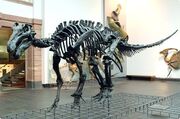
An Iguanodon Skeleton
When the first Iguanodon skeleton was discovered it 1822, was believed to walk much like an iguana, on all four legs. Its thumb spike was believed to be a horn on its head (only one thumb spike was found). At one point it was also thought to have lived in trees, but this has been long since proven completly wrong.
One of the more notable characteristics of the Iguanodon species is its "thumbs". Instead of a thumb it had a large spike that paleontologists believed Iguanodons used for defensive purposes, but could have also been used for getting food. The "pinky" finger of an Iguanodon is believed to have acted as its thumb.
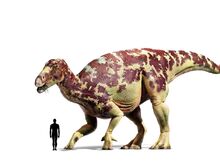
Iguanodon size
Palentologists belive that Iguanodon may have traveled in herds. In large herds of Iguanodons and other dinosaurs, mainly the ankylosaur family, would join in the migrations to gain protection to the herd as a whole, and also additionally providing an escort. It was mostly quadropedic, but could have stood up on its hind legs to reach tall plants or to run away quickly. They didn't have too flat of bills or like their hadrosaur descendents, but still had many teeth within its cheeked jaws and could chew tough food pretty easily. Iguanodon was perhaps the most successful dinosaur species, with it and its relatives being found on nearly every continent.
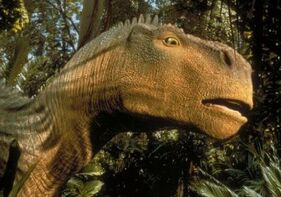
Aladar from Disney's Dinosaur
Popular Culture
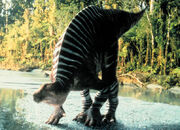
North American Iguanodon in Walking with Dinosaurs, reassigned to Dakotadon as of 2008
Iguanodon has been featured in several dinosaur-related merchandise ever since the early 1990s, reaching high popularity ever since the early 2000s.
- An animated skeleton of Iguanodon was featured in one of the four episodes of the 1992 four part PBS documentary The Dinosaurs!. It was seen in the 1st episode "The Monsters Emerge.", where the skeleton of Iguanodon was changing its position and posture, and began to walk.
- Iguanodon first had its initial major appearance in the famous 1999 Walking with Dinosaurs documentary, and was shown to have travelled in herds with Polacanthus in North America (this Iguanodon species has since been assigned to the newer Dakotadon genus). European variants appear in England and are attacked by a pack of carnivorous Utahraptor, and one of them was killed in the process.
- Iguanodon from South America also appear in the first episode of the Chased By Dinosaurs special from 2002, featuring Nigel Marven. Since then, this Iguanodon species has been reassigned to Macrogryphosaurus.
- Iguanodon appear in various The Land Before Time films and TV series episodes, mostly as either minor or background characters, starting with 1995's The Land Before Time III: The Time of the Great Giving.
- An Iguanodon named Aladar who was raised by lemurs was the main character in the 2000 Disney film, Dinosaur. This film was by far Iguanodon's most popular appearance to date. Aladar was attacked by a Carnotaurus and a pack of Velociraptor, before meeting a herd of Iguanodon and other animals trying to get to a nesting ground valley. Another Iguanodon in the movie was a female who later became Aladar's mate named Neera, her brother named Kron, and the anti-hero named Bruton and Aladdar's true mother.
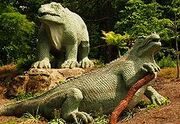
Outdated, Old Iguanodon Statues in Crystal Palace Park, now actually depictions of Mantellodon.
- Iguanodon is one of the statues of dinosaurs in the Crystal Gardens in England.
- It appears in 2001's Jurassic Park III: Park Builder game.
- Iguanodon was planned to appear in the 2003 game Jurassic Park Operation Genesis. For unknown reasons, the development of Iguanodon was terminated. The CD-ROM contains two files containing the parameters of the dinosaur.
- It also featured in an episode of 2003's Dinosaur Planet, where they were attacked by Pyroraptor, Tarascosaurus, and their dwarf forms on the Hateg island. In reality, this was not actually an Iguanodon, but another genus - Rhabdodon.
- An Iguanodon named Iggy appeared in a few episodes of Dinosaur Train.
- Iguanodon are seen in the 2009 Ice Age: Dawn of the Dinosaurs film and video game.
- A skeleton of Iguanodon was featured in David Attenborough's Natural History Museum Alive.
- It appears in Jurassic Park Builder where while it has cheeks, it lacks its classic thumb claw and the head shape is a bit off.
- Iguanodon is a tamable dinosaur in 2015's ARK: Survival Evolved.
- Iguanodon appears in Jurassic World: Alive.
- Iguanodon is an unlockable dinosaur in Jurassic World Evolution, added in the Cretaceous Dinosaur Pack DLC released on December 13, 2018. Its appearance in the game is incredibly accurate (in fact it's one of the most accurate appearances in a video game yet), and is the only ornithopod in the game so far that is capable of defending itself against small and medium carnivores.
- In Papua New Guinea, people have said a few remaining living Iguanodon-like dinosaurs are still alive today, but there is no evidence to confirm its existence.
- Iguanodon made an appearance in the Roblox game called "Dinosaur Simulator."
Gallery
Iguanodon/Gallery